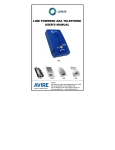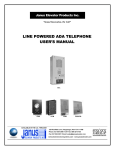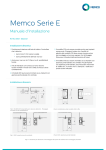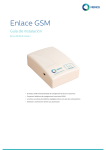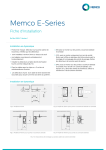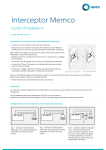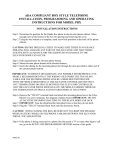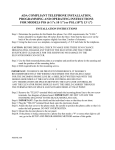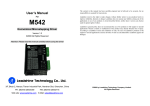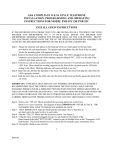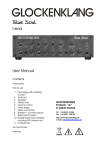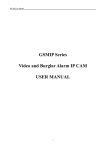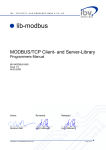Download LINE POWERED ADA TELEPHONE USER`S MANUAL
Transcript
LINE POWERED ADA TELEPHONE USER’S MANUAL PNB-R Avire Inc 415 Oser Avenue, Suite Q, Hauppauge, New York 11788 Phone: 631 864 3699 Toll Free: 800 527 9156 Janus is a brand of Avire Fax: 631 864 2631 Email: [email protected] TABLE OF CONTENTS SECTION PAGE INSTALLATION……………………………………………………………….3 P.C. BOARD DIAGRAM……………………………………………………..4 PROGRAMMING SET-UP METHODS…………………………………….5 PROGRAMMING INSTRUCTIONS………………………………….……..6 OPTIONAL PROGRAMMING INSTRUCTIONS…………………………..6 LIST OF COMMANDS FOR PROGRAMMING MODE.…………………..7 LIST OF COMMANDS FOR CONVERSE MODE……..…………………..8 OPERATING INSTRUCTIONS……………………………………….……..9 AUXILIARY OUTPUTS INFORMATION..………………………………….11 BATTERY & POWER SUPPLY INFORMATION………………………….11 TROUBLESHOOTING GUIDE..…………………………………………….12 SPECIFICATIONS……………………………………………………………15 FCC NOTICE………………………………………………………….………16 WARRANTY POLICY………………………………………………….……..17 RETURN POLICY…………………………………………………………….17 2 Installation 1. Remove the old Rath-Smart Phone board from Plastic bracket. 2. Remove the old Battery from plastic Bracket. 3. Install the new PNB-R board into plastic Bracket keeping the board orientation the same as the Rath-Smart Phone. 4. Plug in the External Call button to P2 SWITCH connector. 5. Plug in the External LED to P6 connector. 6. Plug in the External Speaker to P4 SPK connector. 7. Plug in the External Microphone to the P3 MIC connector. 8. Attach phone line to terminal block at P1 (TELCO) phone jack. 9. Optional Step: If you will be using the AUX2 phone line monitoring option of the phone you must also connect 24V AC/DC power supply to the P9 Power connector and install a jumper at the LM pins. NOTE: The PNB-R Phone is phone line powered. If a battery is needed attach an 8.4V NiMH or a Standard 9V-Alkaline battery to the Battery Lead of the board. Do not use a 9V-Alkaline battery if you are connecting a power supply to the P9 power connector. (See Battery & Power supply section for more information) CAUTION: To reduce or eliminate any possible interference, it is highly recommended that the wiring used inside the traveling cable for the incoming phone line be a 20-22 AWG twisted shielded pair with the shield grounded at the elevator controller end only. Any terminations or splices between the elevator controller and the elevator phone should have the shield carried through the termination of splice and not grounded at that point. 3 PC Board Diagram 4 Programming Set-Up Methods There are two methods of SETTING UP the Hands-Free elevator phone for programming. Select the one applicable to your situation as described below. NOTE: THE TELEPHONE LINE PROVIDED MUST BE A TOUCH-TONE LINE. The Hands-Free telephone can be programmed at any location and then installed in the elevator cab. The phone will retain its programming without the need for a battery. Method A: Calling the Elevator Phone to Program it. 1. 2. 3. 4. From any touch tone phone call the phone number to which the elevator phone is connected. After four rings the elevator phone will turn on automatically and you will hear a diddle-diddle-diddle sound. Go to the “PROGRAMMING INSTRUCTIONS” section. After programming the ADA phone, you should test it by pressing the “CALL” button. The test will assure the phone is functioning correctly and as programmed. Method B: Using the Keypad on the board to program it. 1. 2. 3. 4. 5. 6. 7. 8. Disconnect the phone line from the P1 (TELCO) phone jack. Connect a 9-volt battery to the battery lead of the board. (See diagram of phone board) Press the “PROGRAM” button next to the keypad. Make sure that the red light of the phone turns on. If it does not, go back to step 3 and start again. The elevator phone will turn on and you will hear a diddle-diddle-diddle sound. Go to the “PROGRAMMING INSTRUCTIONS” section. When you have completed the Programming of the phone you can unplug the 9-volt battery. After programming the ADA phone, you should test it by pressing the “CALL” button. The test will assure the phone is functioning correctly and as programmed. 5 Programming Instructions 1. 2. 3. 4. 5. 6. 7. 8. 9. 10. 11. 12. 13. Choose programming setup method A or B. Enter # 94851 to get into programming mode. Listen for three beeps. NOTE ONE: Enter touch tone digits slowly and deliberately. NOTE TWO: Once you are in programming mode, you can perform any programming step in any sequence as long as you get three beeps after your programming entry. Enter # 0 (enter the first phone number to be programmed) * #. Listen for three beeps. EXAMPLE: # 0 5551212 * #. NOTE: If you are on a phone line that requires a "9" or another digit to call the answering service, enter a # after the 9. This will insert a 4 second pause. EXAMPLE: # 09 # 5551212 * #. Enter # 1 (enter the second telephone number to be programmed) * #. (Optional) Enter # 2 (enter the third telephone number to be programmed) * #. (Optional) Enter # 3 (enter the fourth telephone number to be programmed) * #. (Optional) Enter # 4 (ID Code) *# (Optional) Enter # 7 and listen for the single beep. At the beep, record the location message by speaking into the touch-tone phone handset or into the microphone of the HFP phone when using the keypad to program. Enter 0 to end. If you want to listen to the location message without changing it, enter # 8. Enter # * 1180183 * # and listen for three beeps. (Enables Voice prompt messages) Enter # # to exit programming and hang up the phone. Optional Programming Instructions PURPOSE: To Eliminate Autodialing: To disable the dialer from dialing a phone number. (Used on a Ring Down telephone line) Enter # 94851 and listen for three beeps. Enter # 0 * #, listen for three beeps, enter # 1 * #, listen for three beeps. Enter # 2 * #, listen for three beeps, enter # 3 * #, listen for three beeps. Enter # * 1180180 * #, listen for three beeps. (Optional) Enter # # and hang up. PURPOSE: To Disable the Voice Prompt Message: To disable the voice prompt from saying: "Elevator call at the tone press one to talk, press two for Location". Enter # 94851 and listen for three beeps. Enter # * 1180180 * #, listen for three beeps. Enter # # and hang up. CAUTION: This option cannot be used with two or more number dialing. 6 PURPOSE: To Disable Voice Prompt Message and Delay Voice Location Message: To disable the voice prompt and have the location message play automatically every 19 seconds. Enter: # 94851 and listen for three beeps. Enter: # * 1180185 * # and listen for three beeps. Enter: # # and hang up. PURPOSE: To Enable Voice Prompt Message: (DEFAULT) To enable the voice prompt message to say: "Elevator call at the tone press one to talk, press two for Location". Enter # 94851 and listen for three beeps Enter # * 1180183 * # and listen for three beeps. PROGRAM LOCATION MESSAGE (SEE STEP 7 IN PROGRAMMING INSTRUCTIONS) Enter # # and hang up. List of Commands for *Programming Mode *Note: The phone enters Programming mode after completing step 2 of the Programming instructions. #0 1st Phone Number *# #1 2nd Phone Number *# #2 3rd Phone Number *# #3 4th Phone Number *# #4 Identification Code *# #5 XXXX *# - Sets New Programming Access Code (Default XXXX=4851) #6 XXXX *# - Confirms New Programming Access Code #7 - Records Location Message #8 - Plays back Location Message #* 1 XXX Y W Z *# - setup code (Default is: #* 1 180 1 8 3 *#) o XXX – Call Timer [000,060-990], 000=Disable timer o Y – Push Button Control [0-2] [0] – PUSH ON=TURN ON / PUSH AGAIN=PLAY MSG [1] – PUSH ON=TURN ON / PUSH AGAIN=TURN OFF [2] – PUSH&HOLD=TURN ON / RELEASE=TURN OFF [3-8] – PUSH AND HOLD TO TURN ON FOR Y AMOUNT OF SECONDS TO MAKE A CALL. IF PUSH FOR LESS THEN Y AMOUNT OF SECONDS TURN OFF/ PUSH AGAIN=TURN OFF o W – Unit ID [1-8] o Z - Voice Mode [0,3 or 5] **43 XX *# -Ring Time (for outgoing calls) (18-60 range, 50 is default) **44 X *# - AUX1 behavior, 0=disabled (Default), 1 = red led, 3 = VCC mode. **45X*#- Redial, 0=disabled (Default), 1=Dial the number 1 more time, 2=Dial the number 2 more times. 7 **8 XX *# - Set Language (1 = English: default, 2 = Spanish, X= [1-2] (must have 2 digits) Note: **8XX*# - It will play both messages according to the order specified. (Ex// **812*# = English then Spanish or **821*# = Spanish then English) Note: If second message is not used enter ‘0’ for that message. For Example if you want to set to play English only you must program: **810*#. **7 0 *# - Ring-Thru Converse Mode. (Default) With this setting, the HFP will automatically enter two way communication after it has answered an incoming call. **7 1 XXXX *# - Hang Up Converse Mode – Set Access Code. With this setting when the user calls in he/she will hear 3 beeps and has 5 seconds to enter the 4 digit password set by *71. If he/she does not or he enters the wrong code he will hear a long beep and the phone will turn OFF. If he/she enters the correct code a diddle-diddle sound will be heard and 2 way communication will be established. The speaker and microphone will both be muted until the correct code is entered. ## - Exits programming mode **90 *# - Sets the following Default Values: o #*1180183*# - Default Setup Code. o **43 50 *# - Ring Time (for outgoing calls) o **45 0*# - Disable Redial o **70*# - Ring Thru Converse Mode List of Commands for *Converse Mode *Note: The phone enters Converse mode when pressing the program button above the keypad or when receiving an incoming call) 0 or #9 - ACK conversation (blink LEDs depending on LED mode) 1 - Enters Two Way Communication + ACK conversation 2 - Plays Location Message & Alert Message 3 - Renew Call Timer # - Mutes the microphone if no other digit is pressed within 3 seconds. Any other digit including “#” immediately turns it back on. Note: The microphone is not muted while in Keypad mode. #0 - Plays back 1st Phone Number in DTMF tones. #1 - Plays back 2nd Phone Number in DTMF tones. #2 - Plays back 3rd Phone Number in DTMF tones. #3 - Plays back 4th Phone Number in DTMF tones. #4 - Plays back Unit ID in DTMF tones #6 - Plays Firmware Version in DTMF tones ##0 - Plays back 1st Phone Number in Voice. ##1 - Plays back 2nd Phone Number for in Voice. ##2 - Plays back 3rd Phone Number for in Voice. ##3 - Plays back 4th Phone Number for in Voice. 8 ##4 ##6 #* *0 - Plays back Unit ID in Voice. - Plays Firmware Version in Voice. - Hangs Up with 2-3 seconds delay - Hangs the phone up with no delay. 8-Decrease speaker level (3 levels available: Normal, Medium & High) 9-Increase speaker level (3 levels available: Normal, Medium & High) **8-Decrease microphone level (3 levels available: Normal, Medium & High) **9-Increase Microphone level (3 levels available: Normal, Medium & High) Note: Three beeps indicate that the speaker or microphone has been adjusted by one level. The Normal level is the default and it is saved even if the power is removed from the unit. Operating Instructions A: Trapped Passenger Calling Out 1. Passenger presses "CALL" button. Red LED turns “ON”. 2. Passenger hears dial tone and dialing of first phone number. 3. Passenger hears intermittent ringing. 4. Passenger hears a tone two seconds after elevator phone dials and every 7 seconds until the operator responds to the call. 5. If first phone number is not answered within approximately 50 seconds, the elevator phone will hang up and dial the second phone number. The same sequence of events will occur for any additional phone numbers the phone is programmed to call. 6. Once the receiving operator responds to the call with a touch-tone digit the passenger and the operator will be able to communicate. 7. When the Red LED flashes, the operator can request the passenger to press the "CALL" button again. This action will send an audible signal to let operator know that someone is actually stuck in the elevator and not just a prank call. This action is normally only important for someone who cannot speak. B: Responding Operator - with Prompt Message Enabled 1. Operator hears ringing of incoming call from elevator and answers call. 2. Operator hears a repeating message from the elevator phone stating "ELEVATOR CALL, AT THE TONE PRESS ONE TO TALK, PRESS TWO FOR LOCATION". The message will keep repeating until the operator presses a "1" or "2" after the tone on their touch-tone phone. 3. The passenger does not hear any voice messages. 4. Normally the operator should press "1" after the touch-tone at the end of the message to quickly establish two way voice communication with the trapped passenger. 5. At any time the operator can press "2" to hear the location of the elevator. 9 6. In elevators with a lot of background noise, the operator can press # to mute the microphone. Entry of any other digit will re-enable the microphone. 7. At the end of the location message another message will be heard by the operator that Says: "PRESS ZERO TO ALERT PASSENGER OF RESCUE." 8. When the operator presses "0" on their touch-tone phone they will hear three beeps. The Red light flashes. At this point the operator has acknowledged the call. The passenger knows that the call has been received because wording printed on the car operating panel or the phone states “BLINKING INDICATES CALL IS ANSWERED” 9. The operator can request that the passenger press the "CALL" button again. If the passenger presses the button, the operator will hear a diddle-diddle-diddle sound. For the operator, this means that there is a passenger in the elevator. 10. Prior to the phone turning off (normally 3 minutes), the operator will hear this message twice, "TO AVOID DISCONNECT PRESS THREE NOW" 11. If the operator presses "3" on their touch tone phone within ten seconds after this message, the elevator phone will stay on for another three minutes. The message will be repeated every three minutes for the duration of the call so that the operator can keep the passenger on the line until help arrives or as long as needed. 12. Operator presses *0 to hang up the elevator phone. Alternate B - with Delayed Location Message - Voice Mode 5 ALL OPERATING STEPS ARE THE SAME EXCEPT 1. Operator answers incoming call and begins talking to passenger. 2. Within 17 seconds after the call is dialed, the operator will hear the location message followed by this message: "PRESS ZERO TO ALERT PASSENGER OF RESCUE." 3. Both messages will repeat every 20 seconds until the operator enters "0". Operator Calling Into Elevator Phone 1. 2. 3. Operator dials the phone number of the elevator phone and hears ringing. After four rings the elevator phone turns on automatically and operator will hear diddle-diddle-diddle sound. At this time the operator and passenger can talk. All other operations stay the same. Passenger Receiving Call from Operator 1. 2. Passenger hears elevator phone ringing. Phone turns on automatically after 4 rings When elevator phone turns on the passenger and operator can communicate. 10 Auxiliary Outputs Information AUX1: The AUX1 output by default will not be active (Open). If the user will like to activate this output he or she must program code: **44 X *# - which controls the AUX1 behavior. The letter X on this code could be substituted by 0, 1, or 3. 0 = Disabled – The AUX1 will stay OPEN. 1 = Red LED mode – The AUX1 will Close when the Red LED turns ON and Open when the Red LED turns “OFF”. 3 = VCC mode – The AUX1 will Close when the Phone turns ON and Open when the Phone turns “OFF”. AUX2: The AUX2 output is used for phone line monitoring. When a good Phone line is connected to the unit this output is normally open. If it detects a failure on the telephone line or if the line is shorted or disconnected this output will close within 5 minutes. Note: AUX2 will only work if the optional 24V AC/DC power supply is connected to the P9 connector and a jumper is installed at the LM connector on the board. Battery & Power Supply Information The following information explains how to determine when a battery or power supply is needed or when to use a specific type of battery: You will need a 9V battery or a 24V AC/DC power supply with 8.4V NiMH battery when: 1. 2. The phone drops off the telephone line without completing the call. There is more than one phone on the same telephone line and there is a need to call back to a specific elevator phone, or if all elevator phones need to be “ON” at the same time. ALKALINE BATTERY: Can be used on all phone lines. The battery will need to be checked every 6 months. An AC connection is not required and the battery cannot be trickle charged. LITHIUM BATTERY: Can be used on all phone lines. The battery will need to be checked every 12 months. An AC connection is not required and the battery cannot be trickle charged. 24VDC POWER SUPPLY: Can be used on all phone lines. The 8.4V NiMH battery supplied with the power supply will need to be checked every 12 months. An AC connection is required and the battery will be charged by the power supply connected to the P9 connector of the board. The P9 connector is not polarity sensitive. CAUTION: DO NOT use an alkaline or lithium battery when the power supply is connected to the P9 connector. 11 Troubleshooting Guide Always visually check the phone for loose or shorted wires, physically damaged or missing components. The phone will not work on a Digital phone line. It will only work on an Analog phone line or an Analog port from a digital phone system. Problem: Phone would not turn ‘ON’ Possible Cause: • Check phone line connection • Check phone line voltage (Normal C.O. line 48-52VDC or 2035VDC – Internal systems) • Try connecting a fully charged 9-Volt battery. • Make sure phone line is connected to the TELCO P1 modular phone jack. (See P.C. Board Diagram) • Check if unit is pulling down line voltage (You should read the same as the phone line voltage) • Check voltage at controller • Check button connection • Disconnect Call Button wires and try shorting button connection at P2. Problem: Phone Dials Incorrect number Possible Cause: • Check number programmed into phone • Plug a phone in the jack and call the same number you are trying to program to see if you can call out. • Check to see if the phone is on a ring down line • Check to see if another auto dialer is on the line and remove it • Reprogram unit Problem: Low or No sound thru speaker Possible Cause: • Check speaker connection (See P.C. Board Diagram) • Try calling into unit and speaking to person in the car • Try adjusting the Speaker volume by calling into the phone and when it answers press “9” twice to adjust the volume to the maximum level. • Check mounting of the unit. Problem: Noise on the line Possible Cause: • Check if twisted shielded pair was used • Check to see if shield was connected to ground at the controller end only • Measure AC voltage on line, should be zero 12 • • • Check button connection Try a spare pair of wires thru traveling cable Check if wire is running thru hoist way by itself Problem: Phone dials out but has broken communication Possible Cause: • Check if voice prompt message is being stopped • Check if there is loud background noise in cab • Check location of microphone • Check mounting of unit • Try adjusting the Speaker and microphone volumes. (See Page 9) • Check mounting of the unit. • Check to see if person-answering call is using a handset. Headsets that are not properly adjusted, could cause problems Problem: Phone cannot be programmed Possible Cause: • Try holding down keys slowly and deliberately • Try disconnecting the speaker. (See P.C. Board Diagram) • Make sure you are using a touchtone phone • If you are using a cell phone do not stand in the car • Check if phone is hearing tones (see if Red LED flickers when a DTMF tone is received) • Check if twisted shielded pair was used • Check to see if shield was connected to ground at the controller end only • Measure AC voltage on line, should be zero voltage • The phone will only work on an Analog phone system and not digital. Problem: Phone rings busy Possible Cause: • Check if other devices are on the line • Check where phone line is properly connected to the unit • Check voltage on phone line • Check polarity on phone line • Make sure unit is off • Remove our unit from the line to see if line is still busy Problem: Phone does not ring Possible Cause: • Check phone line connection • Check ring voltage (min. 40VAC RMS) 13 • Check phone line ringing with a touch-tone phone. (Disconnect phone line from TELCO P1 phone jack and plug it to a standard touch-tone phone • Problem: Phone Turns ‘ON’ by itself. Possible Cause: • Check phone line on-hook DC voltage. The voltage should be steady 24-52VDC • Check phone line on-hook AC voltage. The voltage should be less then 1VAC. • Check push-button. The button should be a normally open dry contact. If you have questions or problems, please call Avire technical support for assistance at 1-800-527-9156 or scan the QR code below using your smart phone to be connected to our Automated Programming System. (APS-Tel: 631-864-4759) Notes: ____________________________________________________________ ____________________________________________________________ ____________________________________________________________ ____________________________________________________________ ____________________________________________________________ ____________________________________________________________ ____________________________________________________________ ____________________________________________________________ ____________________________________________________________ ____________________________________________________________ ____________________________________________________________ ____________________________________________________________ ____________________________________________________________ ____________________________________________________________ ____________________________________________________________ ____________________________________________________________ ____________________________________________________________ ____________________________________________________________ ____________________________________________________________ ____________________________________________________________ ____________________________________________________________ ____________________________________________________________ 14 Specifications Input connections: One shielded twisted pair communication cable (Shield should be grounded at the controller only) Phone line requirements: Standard (analog) loop start voice grade touchtone telephone line, PBX or key system station analog telephone line. Optional AC adapter: 24V AC/DC @ min. 250mA Power required: on-hook 0 ma Power required: off-hook 20 to 30 ma Phone line voltage: on-hook 24 to 70VDC (nominally 48VDC) Phone line voltage: off-hook 8 to 20VDC (nominally 12VDC) Ring Sensitivity: 40 - 120VAC RMS Dialing: Frequency) DTMF (Dual Tone Multi Frequency Response: 550Hz - 3400Hz, +/- 3db. Operational Loop impedance: 600 ohms FCC Registration: US: NLFTE03B25668 Ringer Equivalency Number: 0.3B 15 FCC Notice The EMS phone complies with Part 68 of the FCC Rules and the requirements adopted by the ACTA. On the bottom of the Printed Circuit Board of this equipment is a label that contains, among other information, the FCC Registration Number and Ringer Equivalence Number (REN) for this equipment. If requested, this number must be provided to the telephone company. The REN is used to determine the number of devices that may be connected to a telephone line. Excessive RENs on a telephone line may result in the devices not ringing in response to an incoming call. In most but not all areas, the sum of RENs should not exceed five (5.0). To be certain of the number of devices that may be connected to a line, as determined by the total RENs, contact the local telephone company. For products approved after July 23, 2001, the REN for this product is part of the product identifier that has the format US:AAAEQ##TXXXX. The digits represented by ## are the REN without a decimal point (e.g., 03 is a REN of 0.3). For earlier products, the REN is separately shown on the label. If the terminal equipment, NLFTE03B25668 causes harm to the telephone network, the telephone company will notify you in advance that temporary discontinuance of service may be required. But if advance notice isn't practical, the telephone company will notify the customer as soon as possible. Also, you will be advised of your right to file a complaint with the FCC if you believe it is necessary. The telephone company may make changes in its facilities, equipment, operations or procedures that could affect the operation of the equipment. If this happens the telephone company will provide advance notice in order for you to make necessary modifications to maintain uninterrupted service. If trouble is experienced with this equipment, NLFTE03B25668 for repair or warranty information, please contact Avire at 1-800-527-9156 or visit us at www.januselevator.com. If the equipment is causing harm to the telephone network, the telephone company may request that you disconnect the equipment until the problem is resolved. Connection to party line service is subject to state tariffs. Contact the state public utility commission, public service commission or corporation commission for information. WHEN PROGRAMMING EMERGENCY NUMBERS AND (OR) MAKING TEST CALLS TO EMERGENCY NUMBERS: 1) Remain on the line and briefly explain to the dispatcher the reason for the call. 2) Perform such activities in the off-peak hours, such as early morning or late evenings. 16 Warranty Policy Avire Inc. warrants its products to be free from defect in materials and workmanship under normal use and service for 24 months from date of purchase. Seller’s obligation shall be limited to repairing or replacing, at its option, free of charge for materials or labor any product which proves defective in materials or workmanship under normal use and service. Avire shall not be responsible for any damage to the unit incurred during installation. Seller shall have no obligation under this Limited Warranty or otherwise if the product is altered or improperly repaired or serviced by anyone other than Avire factory service. For warranty service, contact Avire at 631-864-3699 or 800-527-9156. THERE ARE NO WARRANTIES, EXPRESS OR IMPLIED, OF MERCHANTABILITY, OR FITNESS FOR A PARTICULAR PURPOSE OR OTHERWISE, WHICH EXTEND BEYOND THE DESCRIPTION ON THE FACE HEREOF. IN NO CASE SHALL SELLER BE LIABLE TO ANYONE FOR ANY CONSEQUENTIAL OR INCIDENTAL DAMAGES FOR BREACH OF THIS OR ANY OTHER WARRANTY, EXPRESS OR IMPLIED, OR UPON ANY OTHER BASIS OF LIABILITY WHATSOEVER, EVEN IF THE LOSS IS CAUSED BY THE SELLER’S OWN NEGLIGENCE OR FAULT. Return Policy During installation, if a product does not appear to function properly the installer must call the Avire Technical Support Unit at (800) 527-9156, Monday through Friday. If the technician determines that the product is not functioning, an RA (Return Authorization) number will be issued, allowing the installer to return the product directly to Avire for repair, replacement or credit. Returns with no fault found, will result in a bench charge plus shipping costs. Returns without an RA number will result in a restocking charge of 25% or more plus shipping costs. 17

















